Economic paths diverged in Q1 as Covid-19 infections rose in many parts of the world once
more, leading to further restrictions. At the same time, the US and the UK accelerated their
vaccination programmes, allowing both countries to set a path to reopening well ahead of the
summer. Europe is now seeing an improved rollout as well, while Japan continues to lag. The
situation remains dire in many emerging economies, however, where the lengthy battle to slow
the spread of the virus continues to rage.
The US benefited from President Biden’s $1.9 trillion fiscal package, delivered promptly in a bid
to fuel growth and employment after a loss of momentum in late 2020. While other developed
countries have not seen anything like the same scale of fiscal support as the US, their
economies have nevertheless adapted to the stop-start nature the pandemic has brought and
have fared better than expected during recent bouts of restricted mobility
The US: peak in growth momentum in sight
More than a year has passed since Covid-19 hit the US, stopping the economy in its tracks.
Rapid monetary and fiscal support arrested the slide, lifted financial markets and left households
with additional liquidity even as unemployment rose. After a brief loss of momentum in the final
quarter of 2020, fiscal largesse set a course for the economy to recapture pre-Covid dollar levels
before the summer.
Biden’s first support package, totalling $1.9 trillion, was set in motion via reconciliation after a
swift rejection from the Republican Party. Further sizeable, longer-term programmes tackling
infrastructure, the environment and inequality, among other issues, will be harder to pass.
However, for now, the easing of restrictions for service providers together with bloated
household savings will drive growth of around 6% for this year and reinvigorate the employment
recovery over the coming months, even as less vaccinated states deal with the Delta variant.
Figure 1: US forecasts
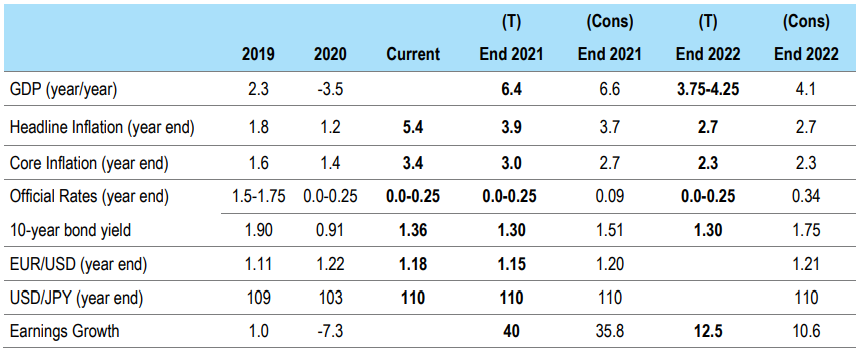
Source: Threadneedle Asset Management Limited/Bloomberg, August 2021. Notes: (T) = TAML forecast, (Cons) = consensus forecast *
denotes interim change. Changes to Threadneedle forecasts: GDP 2021 6.4 from 5.0; Headline Inflation 2021 2.3 from 2.0; Core Inflation
2021 2.2 from 1.7; EUR/USD 2021 1.15 from 1.27; USD/JPY 2021 110 from 100.
Continued support for the economy remains crucial. The Federal Reserve is acutely aware that
the pandemic has disproportionately hit low-income, minority households. Although the ongoing
quantitative easing program will likely be tapered in the new year, Fed Chairman Powell has
stated his intention to leave rates low for however long it takes to aid the repair.
Euro area: playing catch-up
After a stuttering start, Europe’s vaccination rollout has surpassed that of the US. The Delta
variant had a negative effect on Q2 GDP, but economies appear more resilient to restrictions
reintroduced in a number of countries
Indeed, indicators of economic sentiment remain on an upward trajectory, especially in
manufacturing where new orders appear to be driving a post-pandemic boom. So far, the “hard”
data does not reflect increased optimism; it is possible that lags are in play, that disrupted supply
chains are holding back production, or that surveys display excessive optimism, as they did
during the 2017 expansion.
The underlying health of the labour market may not be obvious for some time, as data here
continues to be distorted by large numbers of people engaged in short-term work programmes.
For now, optimism around a vigorous economic recovery rests with the consumer and a robust
run-down of the savings amassed over the past year or so. The largest share of foregone
consumption has occurred within services, where there are obvious limits as to how much can
be recouped. Additionally, as elsewhere, savings have tended to accumulate at the higher end
of both the income and demographic distributions where the propensity to consume is lower, all
else being equal.
Figure 2: Euro area forecasts
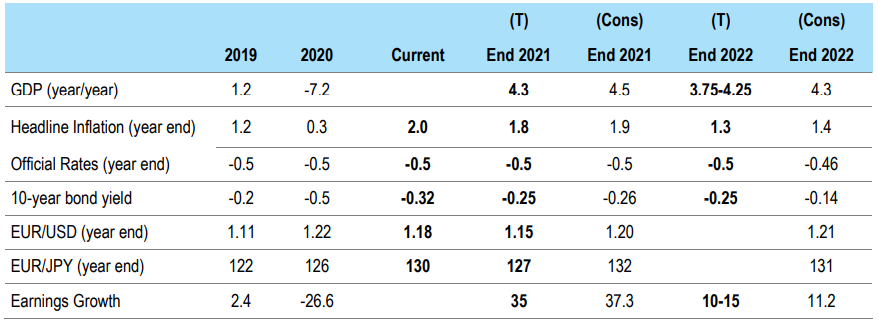
Source: Threadneedle Asset Management Limited/Bloomberg, August 2021. Notes: (T) = TAML forecast, (Cons) = consensus forecast *
denotes interim change. Changes to Threadneedle forecasts: GDP 2021 4.3 from 4.0; Headline Inflation 2021 1.5 from 1.0; Official Rates
2021 -0.5 from -0.6; EUR/USD 2021 1.15 from 1.27.
The European fiscal response appears small compared with the combined US stimulus. In
contrast with their North American counterparts, household disposable incomes have stagnated
since the end of 2019 in the euro area, where support has been largely delivered via job
retention programmes. We believe this will likely lead to a less impressive recovery.
The European Central Bank has adjusted its policy framework closer to that of the Fed, in
allowing for an overshoot of inflation expectations over its forecast period. This implies a lengthy
extension to the existing easy policy. But medium-term hopes for a higher rate of GDP growth
are best pinned on an eventual rotation away from pro-cyclicality in member states’ budget
policies, as embodied in the eurozone’s fiscal framework. It seems likely that the EU’s Stability
and Growth Pact deficit and debt ratio requirements will be suspended until at least 2023.
Negotiations around more permanent changes are likely to resume later this year.
UK: bouncing back, for now
The reopening of the UK economy has continued apace, helped by the success of the
vaccination program. GDP has continued to make swift gains as sectors have gone from
generating zero to low levels of output. However, faster-moving indicators of growth, such as the
employee turnover and card spending data from the Office of National Statistics, point to a
deceleration in consumption growth after the initial burst of spending. The stock of excess
savings held by consumers remains the biggest upside risk to consumption, but the survey data
and details around where these savings are held continue to suggest that destocking will be
modest.
Figure 3: UK forecasts
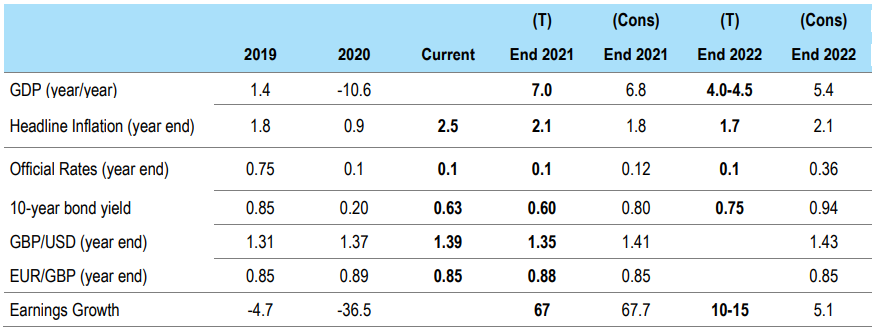
Source: Threadneedle Asset Management Limited/Bloomberg, August 2021. Notes: (T) = TAML forecast, (Cons) = consensus forecast.
Changes to Threadneedle forecasts: GDP 2021 6.5 from 4.0; GDP 2022 4.5-5.0 from 5.5-6.0; Headline Inflation 2021 1.9 from 1.5; Official
Rates 2021 0.1 from -0.1; 10-Year Bond Yield 2021 0.75 from 0.25 GBP/USD 2021 1.30 from 1.40; EUR/GBP 2021 0.88 from 0.91.
Inflation is set to accelerate over coming months in line with global trends, as the inability of
supply chains to adjust to changing consumption patterns and Covid blockages in the near term
leads to higher prices. Wages also appear to be lifting sharply in certain industries such as
logistics and haulage, owing to labour shortages from the conflux of Brexit and Covid. A higher
clearing wage is likely required in the short term, but thereafter increased rates of wage growth
will not be necessary.
Against this backdrop of rising inflation in the near term, but still uncertain trends for growth and
inflation over the longer term, the Bank of England has become slightly more hawkish as the
year has progressed. The extent of policy tightening will be determined by the persistence of
above-trend levels of inflation, and we continue to believe that tightening will not need to be as
aggressive as the market is currently pricing in
Japan: another Covid wave delays a sustained consumer rebound
No changes have been made to Japanese forecasts: the 2021 GDP forecast remains at 3%.
This is above consensus and reliant on anticipated ongoing support from external demand,
unlike the contraction in 2020. Capex is also expected to pick up this year relative to 2020.
Until recently, Japan’s management of Covid had been one of the best in the world. However,
cases and deaths have spiked again, triggering the announcement of a fourth state of
emergency (SoE). This has prompted us to revise our projections on the start of the sustained
rebound in consumer spending to the end of Q3, when vaccine coverage should have picked up
significantly. Japan’s vaccination numbers are currently at around 40%, relative to around 60%
in other developed markets. However, the vaccination rate picked up relatively quickly once the
process started, suggesting that enough inoculations will have been administered by the end of
Q3 to avoid future SoEs
Figure 4: Japan forecasts
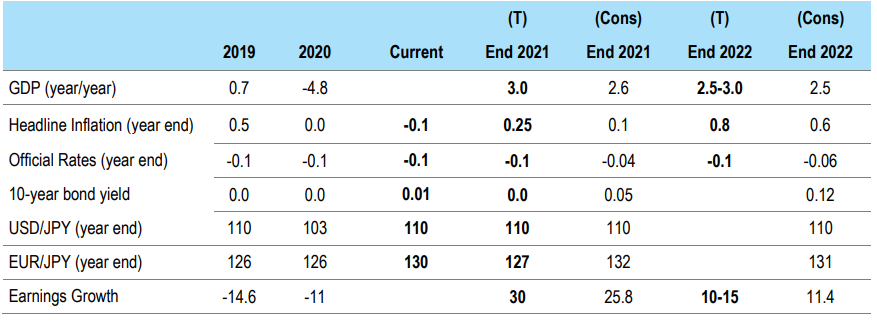
Source: Threadneedle Asset Management Limited/Bloomberg, August 2021. Notes: (T) = TAML forecast, (Cons) = consensus forecast.
Changes to Threadneedle forecasts: GDP 2021 3.5 from 4.0; Headline Inflation 2021 0.25 from 0.5; USD/JPY 2021 110 from 100.
The area of domestic demand that does look set for a strong year is corporate capex; realised
numbers tended to be higher than anticipated in early 2021 and the starting point this year is the
highest level in the past five years. On the external front, trade data remains encouraging and
points to further strong contributions to GDP from net exports in 2021. In addition, growth in
machine tool orders, which leads global and Japanese industrial production by around a quarter,
remain elevated.
Overall, we expect a continued slump in domestic activity until the end of Q3, but ongoing
support from the external component of the economy should make this less severe relative to
last year. Once vaccination levels pick up we expect a strong and sustained rebound in domestic
activity to coincide with ongoing strength in the external component of the economy.
China: balancing systemic risk management with unemployment
The Chinese government was quick to reduce systemic risk by deleveraging the local
government and property sectors. However, the broader environment has not been conducive to
lifting growth in the priority sectors, notably SMEs and manufacturing investments. The
government is also increasingly concerned over job creation. As such, we expect another cut to
the reserve requirement ratio (RRR) in Q4 in order to assure the banking system that liquidity will
not be prematurely or accidentally tightened. We also expect additional fiscal spending for new
infrastructure investments.
The impact on growth of deleveraging of the property sector is likely to be more negative than
the market currently expects. The growth in outstanding property developer bonds fell to -5.9%
year-on-year in Q2, from -2.7% in Q1 and 4.8% in Q4 2020 – well below pre-pandemic levels of
12.5% in 2019. The growth in outstanding RMB loans for property also fell to 9.5% in Q2 2021,
down from 10.9% in Q1 2021 and 14.8% in Q4 2020. This is important as the property sector
contributes between 12% and 16% of China’s GDP, and up to 44% of total tax revenue that
generally funds infrastructure investments at local levels. The growth impact of a contraction in
credit is generally felt with a lag of six to nine months. As such, a further slowdown is
forthcoming.
Figure 5: China forecasts
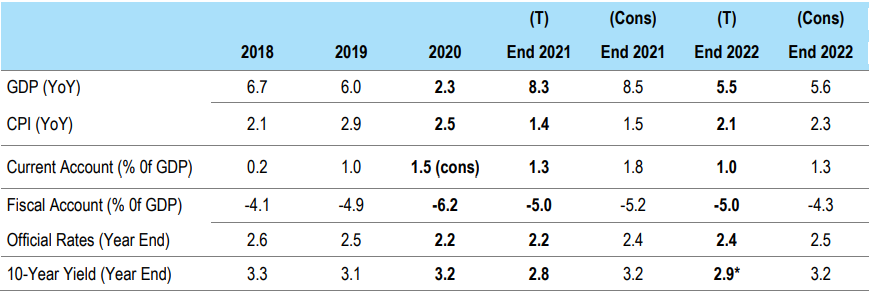
Source: Threadneedle Asset Management Limited/Bloomberg, August 2021. Notes: (T) = TAML forecast, (Cons) = consensus forecast.
This ultimately begs the question of whether China’s recent RRR cut is the start of another
easing cycle, and the extent to which there will be a potential loosening of restrictions and
regulations to prop up overall growth. The latter is unlikely given the recent announcement of
local government debt borrowing criteria and mortgage rate increases in Shanghai. Instead, the
government is expected to increase its efforts to reallocate credit towards manufacturing SMEs,
as these companies are experiencing a further slowdown in hiring and profit growth due to the
surge in raw material prices and shipping costs. For context, in China more than 98.7% of all
firms are small businesses with 300 or fewer employees, which contribute more than 60% to
total GDP and 75% to job creation figures. This segment is also crucial for domestic demand.
In summary, credit growth should stabilise at around 11% in the second half of 2021 from in
excess of 13% in December 2020. Increased government bond issuance and manufacturing
investments/loans to SMEs should offset lower property developer bond issuances and
household mortgages. Ultimately, the government’s aim is to avoid financial asset and debt
bubbles, reduce vulnerabilities to external policy factors, and increase domestic demand. So
long as the target surveyed urban unemployment rate of around 5.5% can be achieved, and 11
million jobs can be created this year, these structural reforms will continue.
Emerging markets: deceleration in the pace of growth
So far in 2021 there has been a divergence in the pace of growth between the US and the rest of
the world. Emerging market (EM) growth has been buoyed by export demand, specifically
commodity demand from the US and China. This driver is expected to normalise in the second
half of the year, with countries likely to depend more on domestic demand to sustain growth.
Looking at recent changes to growth outlooks, forecasts for growth in Asia have been marked
down more than 1% apart from in China and Japan. The main drivers are the resurgence in
Covid-19 cases and supply chain bottlenecks. On the other hand, stimulus has been supportive of
growth in Latin America and EMEA.
Figure 6: EM forecasts
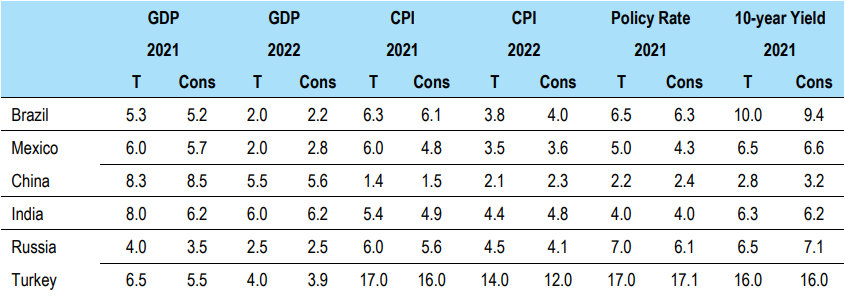
Source: Threadneedle Asset Management Limited, Bloomberg, April 2021. Notes: (T) = TAML forecast, (Cons) = consensus forecast
Two downside risks to track include the resurgence of Covid due to lower vaccination rates in
EMs, and the ability of these countries to sustain incremental stimulus. Fiscal consolidation has
been pushed out, and countries with more vulnerable balance sheets are less able to continue
funding stimulus. Stimulus is largely funded via domestic markets and, in rare instances,
stabilisation funds. While foreign participation has been declining as a percentage of total funding,
debt financing costs have remained low and market access remains healthy
Regarding monetary policy in domestic markets, a broad tightening cycle is underway as EM
central banks front-run the Fed and respond to domestic inflationary pressures. Current account
balances have not been a material concern so far because domestic demand has been muted,
but we are expecting this trend to turn around in the next year as domestic demand returns.
The political environment in EMs reflects limited government support and rapidly rising poverty
rates, which could result in increased uncertainty around political transitions and social unrest.
Rising food prices are historically a precursor to instability in EMs, and this year is no different.
Corporate profitability recovered quickly in EMs. With lower vaccination rates there is continued
uncertainty around Covid. Therefore, we expect most EM corporates to continue to prioritise
deleveraging and capex in the second half of 2021, but increased pressure is likely to make
shareholder distributions a focus in 2022.
In summary, we expect continued growth at a slower pace in EMs.





